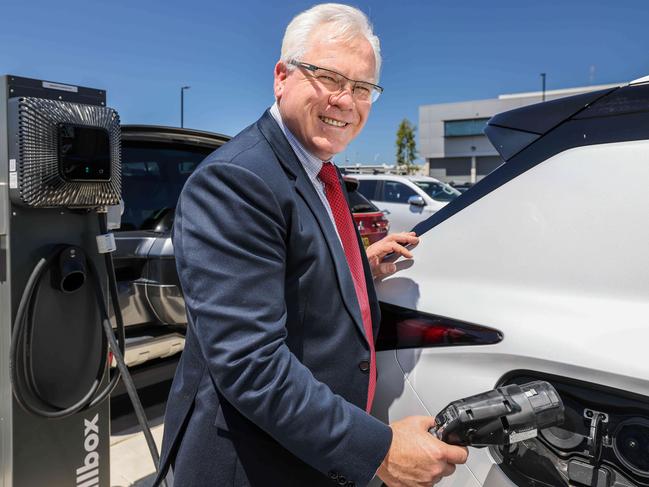Home batteries on wheels: Mitsubishi boss says SA is poised to drive an energy evolution
SA has become the first state that allows electric cars to supply battery power to homes, and Mitsubishi’s boss says this could be a game-changer.
SA News
Don't miss out on the headlines from SA News. Followed categories will be added to My News.
South Australia is poised to become a pioneer in using electric car batteries to supply power to homes after a nation-first trial at Mitsubishi’s Adelaide head office.
Two bi-directional charger/inverters have been installed at the firm’s Adelaide Airport headquarters, which allows plug-in hybrid electric vehicles (PHEVs) to both charge their batteries and supply stored power back to the grid.
In an interview with The Advertiser, Mitsubishi Motors Australia chief executive officer Shaun Westcott urged a change in Australian standards to allow electric cars to effectively become “batteries on wheels” – current rules require household batteries to be attached to a wall.
The installation of the charger/inverter units for the trial, which started on February 3, was approved by SA Power Networks (SAPN), which operates the state’s grid.
SAPN in December became the nation’s first electricity distributor to allow electric vehicles to be connected to the grid, which requires a special electricity charger/inverter used in the Mitsubishi trial and expected to soon become available in SA.

Australia has lagged other countries – Mitsubishi supplied PHEV Outlanders to governments for emergency power during 2018 floods in Japan, as well as after major earthquakes.
Mr Westcott said the technology should be able to be deployed nationally.
“We need to do this across the country. The rest of the states need to follow the example of South Australia, so whatever we do to enable it in South Australia needs to be replicated across Australia,” he said.
“This is an opportunity not only to save yourself significantly on petrol bills, but this is an opportunity for your car to offset some of the cost of running your house, to reduce electricity bills.
“So the car starts paying for itself in multiple ways. I would anticipate an eagerness by customers and consumers to adopt this type of technology.”
A Standards Australia spokesman said there was “a pressing need to look at how all these technologies come together” and the authority was working co-operatively with groups including the Australian Energy Market Operator “to help bring this technology to our market”.
“We need to make sure that we’re lining all the pieces up here in Australia, including the good use of international and national standards, which are being worked on now,“ he said.
Energy Minister Tom Koutsantonis said the state government was “optimistic about any innovation in the smart-charging space”, and was “closely monitoring and supporting various trials of vehicle-to-grid technology”.
Approving the inverter technology on December 22, SAPN said bi-directional inverters required to enable household use would be available from early 2023. They cost more than $10,000.
The bi-directional charging allows a vehicle’s on-board battery to be used for supplying homes, business, or energy back to the grid.
It also can be used to store electricity during low demand, then sell back to the grid when prices and demand are high.
AC electricity from the grid is converted to DC electricity required by electric vehicle batteries, but stored energy can also be drawn back from the vehicle’s battery.
At Mitsubishi’s Adelaide head office, two bi-directional charger/inverters, coupled with PHEV battery storage, have been integrated into the existing building smart energy management system and 100kW solar array.
Mr Westcott said SA’s world-leading embrace of renewable energy gave it a competitive advantage in adopting electric vehicles as battery storage.
“In Australia, I think we are slightly behind the curve, in terms of our charging infrastructure is not there yet, but also we need to look at the source of where power is generated and how that power is generated,” he said.
“South Australia is in a very unique position, in that we do have the highest penetration of solar in the world on the rooftops, which leads to another dimension of challenges that a lot of that power is ‘use it or lose it’ at the moment – we have no way of capturing that.”
Mr Westcott argued Mitsubishi’s technology gave the firm a competitive advantage.
“If more people buy Mitsubishi cars, or EVs in the future which have that capability, we can soak up that energy in the daytime, put it in the car, store it in the car and put it back onto the grid at a time when you need it. Whether that’s peak energy times or in the time of disaster, we can then support the grid. So your car becomes no longer a mobility solution, but it becomes part of a total eco-energy system.”
SA Power Networks corporate affairs head Paul Roberts said other bi-directional inverters besides the Wallbox Quasar used by Mitsubishi would soon become available.
“This is very much part of the future, where customers invest in various energy sources, such as rooftop solar, home batteries and vehicle batteries, and are more active participants in the supply and management of electricity,” he said.
“In the long term, we see people taking advantage of cheap energy during the day to charge their vehicles and then being able to sell that energy back into the grid at peak times when it may be needed.”
Besides Mitsubishi’s Outlander and Eclipse Cross models, Mr Roberts said Nissan’s Leaf also was capable of sending power from on-board batteries back to the grid.





